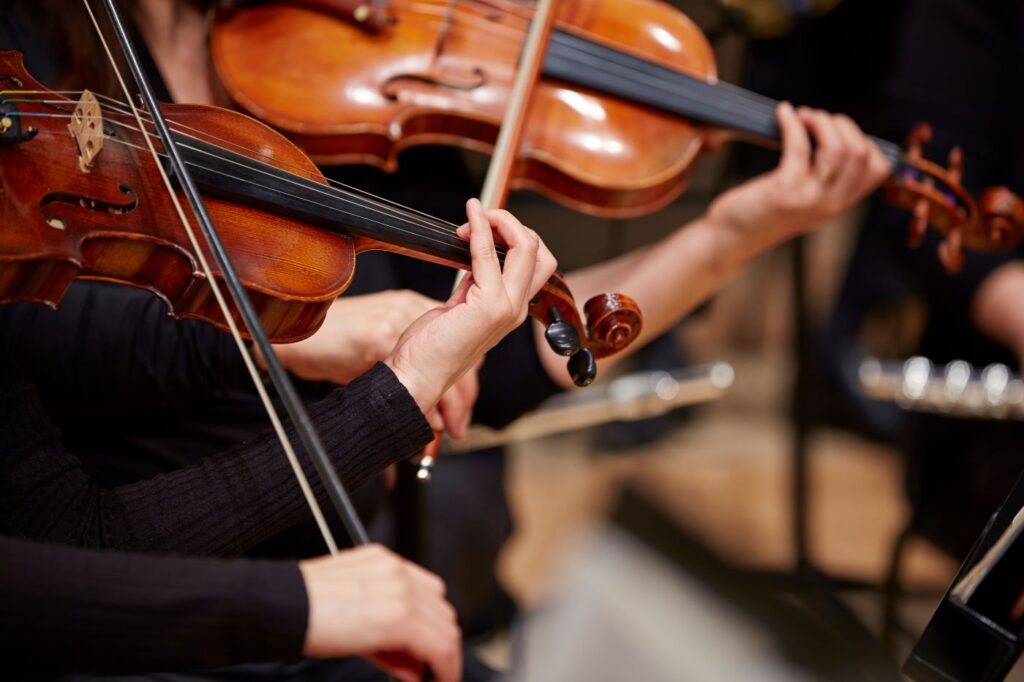Amid political polarization and concerns about declining social capital, local classical music associations are a bright spot for building humane and civil communities. Every aspect of music-making—including the instruments themselves—connects us with the past and with each other. The discipline required to learn music, the earthen character of instruments, the intergenerational interaction that occurs in practice and performance, the communal nature of playing with others, and the reliance on composers and luthiers who preceded us suggest classical music has a place in forming community.
Music and Memory
My daughters dragged their feet when I called them inside from their forest adventures. We had to get ready to leave for a community orchestra concert, their first symphony experience. Frankly, relaxing at home that Saturday evening seemed the more appealing option, and my daughters’ resistance tempted me to give in. Nevertheless, I looked up the concert information we had received from my daughters’ orchestra director. The symphony featured a soloist playing on the Red Mendelssohn Stradivarius violin. I could not pass up the opportunity to hear a Stradivarius in person and to share that experience with my young daughters.
We arrived at the high school auditorium for the concert, where the most expensive ticket cost a mere twenty dollars. We were not an impressive audience—mostly senior citizens in comfortable, casual clothing, the occasional toddler, and a few families with school-aged children—a striking contrast to the virtuoso who was about to play.
The soloist stepped out in a black, floor-length gown, sparkling with embroidered sequin flowers that reflected the concert’s naturalist theme of birdsongs. Stradivarius instruments are known for their singularly sweet sound, and the Red Violin did not disappoint. The soloist swayed with feeling, closing her eyes at profound moments. The audience was still as her vibrato carried the sound to every corner of the auditorium.
Start your day with Public Discourse
Sign up and get our daily essays sent straight to your inbox.The conductor then recounted that the community orchestra’s founder—my daughters’ own orchestra director—had been this soloist’s first violin instructor. The orchestra director’s humility prevented her from mentioning this incredible detail in her email about the performance. The soloist’s first violin concert had been at the local library my children and I frequent. I was amazed to know our local library had been the launchpad for this star’s career.
The only force that could silence the appreciative audience’s applause was the soloist’s offer to play an encore. She chose a Bach sonata, written in the same year that her violin was made: 1720. Both the instrument and the music pre-existed all of us in the room, but we, like so many before us, listened and enjoyed, becoming part of a larger, ongoing story that connects us with each other, with the past, with the earth, and with the future.
That night, my daughters and I became part of the story of the Red Violin, an admittedly small part. Yet this small part situated us in the history of our local community, of the composer, and of the luthier who created that instrument. We communed with our main street neighbors, with the composers who recorded their gifted genius in written form that could be replayed by orchestras, with the luthiers who used their hands to form wood into vessels of sound, and with the musicians who that night applied their creative and disciplined technique to old instruments to create awe-inspiring music together.
The creation of stringed instruments connects us to the past and the future, calling us to conserve and to hope. The violin itself originated from the wood of a tree that germinated centuries ago, was masterfully cut and finished by human hands, and radiated a sweet sound that the best technology today cannot come close to mimicking. It has traversed the earth longer than any of us, and is a keeper of memories. We became part of its memory in the local concert hall that night.
The pernambuco wood from which the finest bows are crafted can best be used after the tree is old, a hundred years or more. We cannot rush the wood’s aging process. Thus, the creation of new pernambuco bows requires a reliance on the generosity of those who went before us and a continual investment in wood and woodworking. We plant trees that will outlive us. We hope that those who come after us will continue to value the trees’ cultivation, allowing them to mature into the rich wood that only weathering time can give. We believe others will continue to pass on the master craftsmanship required to shape and form the aged wood into a musician’s tool. We trust that musicians will continue to teach technique and tradition to future young people who will learn how to play the instruments themselves. The mystery of why Stradivarius instruments sound magnificent humbles us and reminds us that our technological advances are not the pinnacle of human achievement.
That night, my daughters and I became part of the story of the Red Violin, an admittedly small part. Yet this small part situated us in the history of our local community, of the composer, and of the luthier who created that instrument.
Growing Together
Admittedly, two hours is a long time for young children to sit through a concert. Even if they had not loved the music, the discipline to be still and to let the mind wander, all while surrounded by those who love them and situated in the local community we inhabit, is both a discipline and a liberty. The mastery of self-control offered discipline, and the freedom to get lost in their thoughts provided them the leisurely space to ponder.
The concert offered a promise that if they have the grit to keep practicing well, they, too, can create music like what we heard that night. Creating decent sound requires practice, humility to learn, attention to detail, rhythm, motor skills, and coordination. Hearing symphonic music helps students persevere through the effort necessary to make it.
I believe good music is good for its own sake. At the same time, the physical benefits of playing an instrument are life-giving and practical. For instance, the fine motor skills that develop from years of playing an instrument are highly necessary for the life-saving work of surgeons. Today young people often lack such skills, which other generations learned through hands-on crafts. At the other end of the spectrum, studies find that playing an instrument may improve cognition in older adults.
Orchestral music also provides a context for intergenerational relationships to form. During intermission at the concert we attended, the older people sitting behind us asked my daughters if they played instruments. Upon learning that they did, our older neighbors encouraged my daughters, reinforcing the idea that they can play with the orchestra too one day, if they practice well.
At the same time, my young daughters radiated a sense of joy and wonder that inspired the adults. As adults, we can easily overlook something majestic, as trials in life have dulled our senses to the beauty right in front of us. The social experiment in which the violin virtuoso Joshua Bell played his Stradivarius in plain clothes during rush hour in the D.C. metro makes this clear: of the thousand people who passed him that morning, children were the only demographic who uniformly noticed and paused to listen to the music. As the observing columnist summarized, “Every single time a child walked past, he or she tried to stop and watch. And every single time, a parent scooted the kid away.” Incredible music offers us childlike wonder and marvel, and children help us notice it in the first place.
Creating music is in itself a cooperative project, one that often involves members of different generations and demographics coming together to create a work of art. Classical music only works if everyone plays well together. Playing it requires us to listen to others; to tune our instruments to the same pitch; to submit to the same conductor to guide us on the music’s path; and, when unavoidable human error happens, to keep moving beyond our mistakes to join others where they are. In an orchestra, others depend on us, and we on them. The design is inherently community-building. In his creation myth, J. R. R. Tolkien used song to form worlds. His Silmarillion describes the transformation of nothingness this way: “The music and the echo of the music went out into the Void, and it was not void.” In Tolkien’s fantasy, as in real life, individual parts blend into harmonies, which in time reveal cherished communities.
Looking at a timeline of composers reminded me of what the American founding fathers heard in their homes: Mozart, Corelli, Bach, Handel, and many others. Perhaps the musical genius circulating at the time reflected or inspired political order, on the small, local level out of which sprang civic associations, neighborliness, and fortitude. They had no instant streaming, no blaring speakers. The music they heard was only what they and their fellow neighbors could create together, in person. In the same way in our age, creating music with our neighbors might help revive a healthy civic culture.
Image by mnimage and licensed via Adobe Stock.













